Exchange robots are automated software, the main function of which is the implementation of trading operations on the exchange. In addition, such tools are referred to as trading advisors, experts or succinctly - robots. These programs are also called mechanical trading systems, or MTS for short. Today, most financial markets such as Forex, RTS, or the stock exchange have such tools. Every year, part of the automated trading operations in the total volume of transactions increases. For example, on RTS, from 35 to 60% of daily trading activities are carried out by exchange robots. In countries of the Western world, these figures can reach 90%.
What's better?
It should be emphasized that in this case we are not talking about the fact that automated systems are smarter or more efficient than humans. This issue is quite controversial and has not yet been fully studied. The fact is that mechanical trading systems have a number of advantages that a trader engaged in manual trading does not have. Among the well-known and well-established sites that allow automatic trading, you can name Forex4you and Alpari. Next, we will consider the classification of these mechanical systems, their advantages and disadvantages.
Classification of exchange robots
There is no general classification of exchange robots. Nevertheless, these tools are divided into several conditional types that allow a better understanding of the essence of their work. So, mechanical trading systems differ in the style of trading. In this regard, there are scalpers or pipsers, trending instruments, reversal and other trading robots. In addition, there are fully automatic and semi-automatic systems. After the initial setup by a trader, an automatic robot for exchange trading makes operations absolutely independently. At the same time, semi-automatic systems only accompany and close a deal, and a person opens it manually.
Martingale robots
In addition, exchange robots are divided into those that use the Martingale concept, and those that do not apply it. The former are quite aggressive systems that, when lost, increase the bet and are able to easily lose the investor's deposit. Judging by the reviews, trading robots that do not use the Martingale concept, but which show good results regarding profitability, are effective advisers. They apply some market patterns in their activities, which makes them less risky. Such robots are perfect for stable trading activities designed for the long term.

The above does not mean at all that Martingale robots are not able to make good money for a trader. Reviews say that they can also be effective, but when using these systems it is very important to correctly carry out money management. In other words, the trader will be required to timely withdraw from the turnover part of the profit, so that if you lose your deposit, you will not lose all the funds. An example of a robot that successfully works on the basis of the Martingale concept is the TrioDancer Expert Advisor.
Strengths of Exchange Robots
Among the advantages of mechanical trading systems, several of the most important can be distinguished. For example, strict adherence to the trading algorithm specified by the trader. Exchange robots will not back down from installations. In addition, they sequentially perform the actions that are programmed. How does a stock robot work? The system does everything thoroughly and methodically. You can’t say about a trader who can rush around, change the trading plan on the go and perform other emotional actions.
Another advantage of the robot can be called just the lack of emotions and spontaneity. Such systems are not affected by affects. A person is able to experience fear, succumb to panic, to be greedy. All these qualities significantly affect the process and results of trading. The car does not have this.
Also, the advantages of mechanical trading systems include high speed and efficiency. No trader is able to process such a quantity of information as a stock exchange robot with high speed (many reviews confirm this). Only automated experts can almost instantly open or close a huge number of transactions. Such abilities of robots are successfully used when working on financial platforms, primarily on the stock exchange or futures market.
Disadvantages of exchange robots
The disadvantages of automated trading systems include the need for permanent control over the trading activities of robots. Any, even the smartest car needs to be constantly checked. This is due to the fact that the characteristics of a particular market are changing, important economic or political news appear that have a serious impact on strategies for exchange robots. If you do not correct the settings of automatic advisers in time, then their activity may become unprofitable.
Another disadvantage of using such systems is the need to pay for a dedicated IPS server. On the one hand, today renting a good server costs insignificant 5-10 US dollars per month, but on the other hand, it is still financial costs. They must be taken into account when trading. Thus, profits from mechanized trading should cover the costs of acquiring a robot and renting a server.
The cost of paid exchange robots
Among the other disadvantages of using automatic advisers, reviews sometimes call the price of such pleasure as a stock robot a bit too high. How much does a good mechanical system cost? The cost of some exchange robots reaches 500-1 thousand US dollars, and often exceeds these figures. Their purchase is not always advisable, because despite the guarantees of the seller or the developer of the program for the return of invested funds, you can easily buy a pig in a poke. By the way, it is worth noting that the Internet has a lot of good enough automatic advisers that are distributed free of charge, and at the same time are able to bring a constant profit to the trader.
Choosing a stock robot
When choosing a specific mechanical trading system, it is important to pay attention to the algorithm of the exchange robot. In addition, you should analyze the parameters of the program, the rules for opening and closing positions. It is also necessary to pay attention to the presence of a normally tuned mechanism that limits financial losses. Otherwise, trading performance will be difficult to predict.

Along with the above, there are several more aspects, following which will help to choose a good exchange robot. So, it is necessary to test the system in operation, to evaluate its reliability. Advisor should function strictly in accordance with the plan chosen by the trader. In addition, working with the program should be easy and understandable. This applies to the interface, settings and other system parameters. It will be the way to say that the abundance of windows and different buttons only complicates the task of managing the program. Another important point when choosing a stock robot is the ease of installing software on a PC and changes to the application of a trading account. The simplicity of these operations will allow you to use the adviser on any computer, as well as quickly change the brokerage account.
Reviews say that you should be careful not to buy exchange robots from little-known developers or individuals. Savings in this matter can result in unnecessary difficulties when installing the program, its configuration and operation. In addition, you can lose money, and without having received the desired financial result. It is recommended that you select those developers who provide training on working with the system and good, fast and ongoing technical support for users.
Afterword
In conclusion, I want to emphasize once again that the use of exchange robots is a great chance to try yourself in automated trading and regularly receive good income from their activities. However, in this case, the trader’s understanding of the processes and the periodic adjustment of the program are still important. The use of automatic solutions requires a balanced and responsible attitude. With this approach, the investor will definitely make a profit. At the same time, one should not forget that the success of work in the markets largely depends on the broker chosen by the investor.